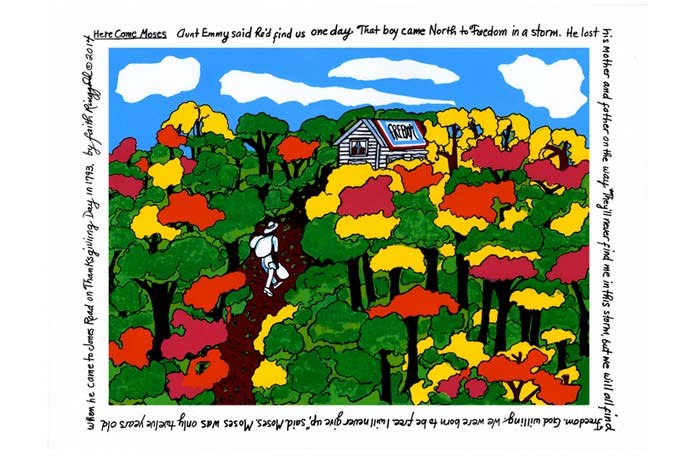
Faith Ringgold “Here Come Moses”
Produced August 2014
Master Printers: Curlee Raven Holton & Jase Clark
“Here Come Moses. Aunt Emmy said he’d find us one day. That boy came North to Freedom in a storm. He lost his mother and father on the way. ‘They’ll never find me in this storm, but we’ll all find Freedom. God Willing. We were born to be free. I will never give up,’ said Moses. Moses was only twelve years old when he came to Jones Road on Thanksgiving Day in 1793.”
The Print Club of New York’s 2014 commissioned print is part of artist Faith Ringgold’s “Jones Road” series. She said it draws from the roles of both the Underground Railroad and the Great Migration in African-American history. However, Ringgold also noted that the “Jones Road” series is personal. The project was the result of the challenges presented by hostile neighbors when she moved to Englewood, NJ on November 23, 1992. Her dream to build a studio and have a garden was seen as a “threat to the ‘quality’ of their lives.” For six years, various roadblocks were placed in the way of realizing her dream, but she persisted. She found in her art a way of healing and a source for finding beauty and strength. She noted that, “art is a healer and the sheer beauty of living in a garden amidst trees, plants and flowers has inspired me to look away from my neighbors’ unfounded animosity toward me and focus my attention on the stalwart tradition of black people who had come to New Jersey centuries before me.”
Faith Ringgold created this image while working with the Experimental Printmaking Institute at Lafayette College and Master Printer Curlee Raven Holton. Since they have worked together many times in the past, she trusted him to capture her signature style. This image was composed by Faith with sensitivity to the unique processes utilized in serigraph printing. EPI also mixes a specific color palette based on a color chart created by Ringgold and uses it as a guide during the printing process.
A combination of computer and hand separation methods were used to produce the 11 independent screens. Each screen represented a significant area of color and defining lines of the composition and border text. The colors were mixed using a color chart produced by the artist as well as a side-by-side comparison to the original work of art. Transparent inks were used with Faith’s primary palette to capture subtle changes in color and to produce the full range of colors needed. For instance, green is printed under certain areas of the transparent brown; this serves to not only increase the richness and tones, but also to create another color. Eleven separate colors were used, and all screens were mounted on a vacuum press and pulled individually to insure an accurate registration and complete covering of the color. With the application of transparent inks, a total of 15 different colors are visible.
